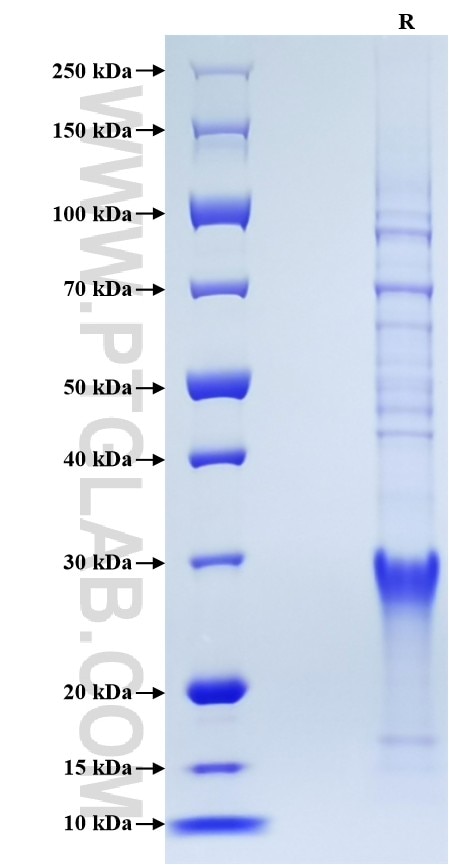Recombinant Human CD8a protein (His Tag)
Species
Human
Purity
>70 %, SDS-PAGE
Tag
His Tag
Activity
not tested
Cat no : Eg0819
Validation Data Gallery
Product Information
| Purity | >70 %, SDS-PAGE |
| Endotoxin | <0.1 EU/μg protein, LAL method |
| Activity |
Not tested |
| Expression | HEK293-derived Human CD8a protein Ser22-Asp182 (Accession# P01732-1) with a His tag at the C-terminus. |
| GeneID | 925 |
| Accession | P01732-1 |
| PredictedSize | 18.7 kDa |
| SDS-PAGE | 27-30 kDa, reducing (R) conditions |
| Formulation | Lyophilized from 0.22 μm filtered solution in PBS, pH 7.4. Normally 5% trehalose and 5% mannitol are added as protectants before lyophilization. |
| Reconstitution | Briefly centrifuge the tube before opening. Reconstitute at 0.1-0.5 mg/mL in sterile water. |
| Storage Conditions |
It is recommended that the protein be aliquoted for optimal storage. Avoid repeated freeze-thaw cycles.
|
| Shipping | The product is shipped at ambient temperature. Upon receipt, store it immediately at the recommended temperature. |
Background
CD8 is a transmembrane glycoprotein composed of two disulfide-linked chains. It can be present as a homodimer of CD8α or as a heterodimer of CD8α and CD8β. CD8a (CD8α) is a subunit of this complex. CD8 is found on most thymocytes. The majority of class I-restricted T cells express mostly the CD8αβ heterodimer while CD8αα homodimers alone have been found on some gut intraepithelial T cells , on some T cell receptor (TCR) γδ T cells and on NK cells. CD8 acts as a co-receptor that binds to MHC class-I and participates in cytotoxic T cell activation. During T cell development, CD8 is required for positive selection of CD4-/CD8+ T cells.
References:
1. Shiue, L et al. The Journal of experimental medicine vol. 168,6 (1988): 1993-2005. 2. Hennecke, S, and P Cosson. The Journal of biological chemistry vol. 268,35 (1993): 26607-12. 3. Terry, L A et al. Tissue antigens vol. 35,2 (1990): 82-91. 4. Moebius, U et al. European journal of immunology vol. 21,8 (1991): 1793-800. 5. Boursier, J P et al. The Journal of biological chemistry vol. 268,3 (1993): 2013-20. 6. Zúñiga-Pflücker, J C et al. The Journal of experimental medicine vol. 171,2 (1990): 427-37. 7. O'Rourke, A M, and M F Mescher. Immunology today vol. 14,4 (1993): 183-8.

